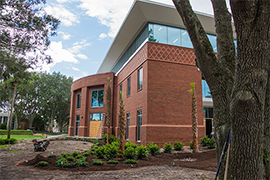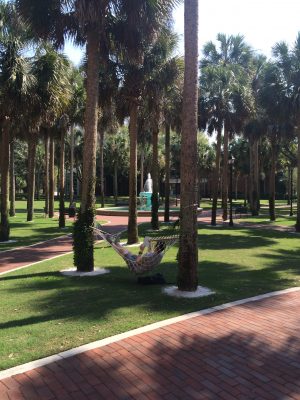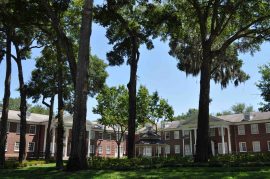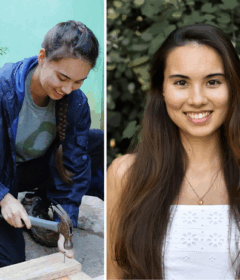Good to be Green


The seeds Wendy B. Libby, Ph.D., planted early in her tenure as president at Stetson University have clearly taken root.
When Libby arrived seven years ago on the main campus in DeLand, Fla., she found an institution with a rich history. Also, while the university was enjoying some growth, the general landscape wasn’t overwhelmingly fertile, literally.
Stetson, although already committed to environmental stewardship, even as part of its core values, needed a refreshed approach toward green.
“When I first visited the campus, I was impressed with many of the things I saw,” she remembers. “However, I thought the grounds, the landscaping, looked tired because the level of funding we had, quite rightly, needed to be devoted exclusively to student learning and the academic programs.
“The issue was not a lack of smarts to know what would look good, but rather a lack of finances to devote to the buildings and landscape.”
Libby worked with an executive team to change that equation.
A Strategic Map, initially in place from 2011 to 2014 then revised to its current iteration, was crafted to strengthen Stetson’s national prominence, recruitment and retention, academic quality, the university’s reputation as “a great place to work,” and the concept of uniting the university as “One Stetson” to advance together, among other areas.
Also, a revived emphasis on the environment and campus beauty were made part of the plan.
An environmental council had been in place for years, and Stetson had signed the American College & University Presidents’ Climate Commitment, an initiative to help eliminate net greenhouse gas emissions from specified campus operations and promote related education. Further, several other steps over the years had been taken to conserve resources and safeguard the environment.
“There were many things in place before I got here,” Libby affirms.
So, Libby simply rallied the troops. With conversation and collaboration, new answers emerged.
Libby points to George Herbst, then CFO and vice president of business affairs, stating, “He had a fabulous eye for landscape and architectural detail.”
She also cites Dave Rigsby, manager for grounds and senior assistant for special projects, and his grounds crew, commenting, “They knew the right things to do.”
The goal was to become “greener, cleaner and safer.”
Done.
“I wanted to literally breathe life into the campus,” Libby says. “I wanted this campus to be energy efficient and ecologically sound, and at the same time look beautiful. We’ve made great strides.”
Consider these advancements made since 2010:

- Approximately 1,200 native trees and 8,000 native shrubs have been planted on the historic campus. Also during that time, Stetson has become part of Tree Campus USA® and created a tree advisory board.
- Annual water usage has steadily declined, even while the campus population has grown 35 percent. As a result, Stetson has a “neutral” impact on the Floridan Aquifer, meaning everything taken out of the aquifer is replaced. Most recently, from July 2015 to June 2016 water usage decreased 2.3 million gallons from the same time period the previous year, thanks to the use of reclaimed water for irrigation, enhanced technologies in bathrooms and generally heightened awareness about conservation, among other factors. (That’s 2.3 million gallons less consumption of the Floridan Aquifer.) Bathroom renovations alone have resulted in 75 percent less water consumption. Notably, in the few areas where reclaimed water currently is inaccessible, irrigation won’t occur.
- Energy use and carbon emissions both are down, as new and more efficient equipment has been installed. In 2010-11, for example, low-voltage LED lighting and window film were added on campus, resulting in a reduction of 1.4 million kilowatts. During 2015-16 carbon dioxide emissions declined by 1,893 metric tons across Stetson’s three campuses. That equates to 400 automobiles being taken off the road for one year.
- In 2015, Stetson contracted with Cenergistic, a Dallas-based company that leverages data and technology to create energy conservation. Stetson officials are working with Cenergistic to schedule energy demands more efficiently by, for example, monitoring the use of air conditioning during holidays and changing consumption behaviors (reminding Hatters to raise thermostats and turn off lights when leaving rooms). At Stetson’s College of Law in Gulfport, Fla., the recently implemented Cenergistic program “exceeded expectations.”
- Several residence halls have new AC systems that better control air flow throughout the buildings, helping to manage humidity and keep rooms cool even when individual room wall units are off. Similarly, Davis Hall, an academic facility, has an all-new system. Also, in Gordis, Smith and Nemec residents’ halls, the hot water tanks that serve the students have been replaced with energy-efficient equipment.

- The Marshall and Vera Lea Rinker Welcome Center, to be completed this month, has earned Green Globe Certification, which includes 44 core criteria for conservation supported by more than 380 compliance indicators. Green Globe is considered more stringent than LEED certification.
- At the College of Law campus, an ongoing annual budget of $20,000 has been established to address energy-consumption efficiencies. Low-maintenance/low-needs plants often are used in landscaping to conserve resources. Reclaimed water is used exclusively in all landscape irrigation areas while new landscape planting beds are irrigated with low-volume drip irrigation. Also, most exterior and landscape lighting has been upgraded to LED.
- College of Law environmental advocacy students have completed projects on campus that include creating and maintaining an organic vegetable garden and launching a bike-share program with the support of the student Environmental Law Society and Stetson’s Institute for Biodiversity Law and Policy.
- University officials across are working to raise awareness by delivering the following message to students, faculty and staff: Continued improvements in resource conservation requires everyone’s help. Turn off lights when leaving rooms; turn off computers, devices and appliances when not in use; lower window blinds and shades; turn up the thermostat; and shut off water when washing hands.
“It’s good to be green,” said Libby, noting that, coincidentally, green is a part of the university’s official colors. “We will continue to invest in our environment, conservation and beautification. That’s just part of who we are now.”
By Michael Candelaria



